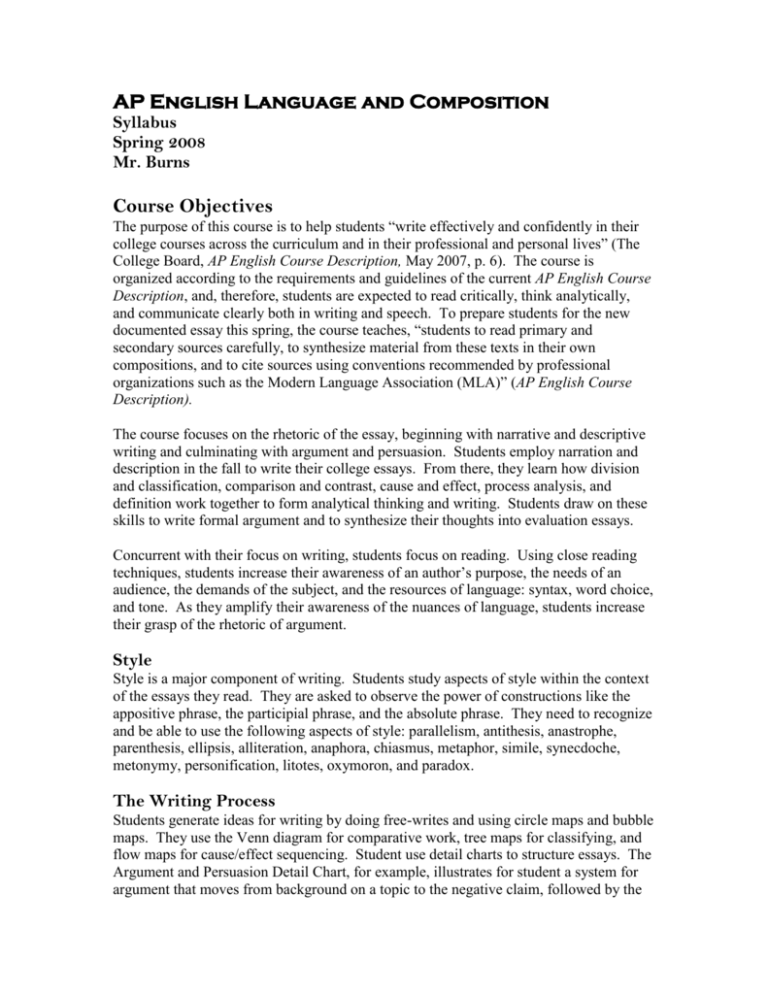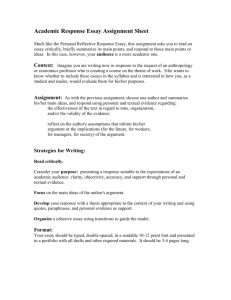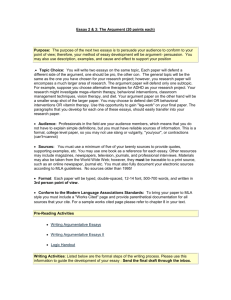
AP English Language and Composition
Syllabus
Spring 2008
Mr. Burns
Course Objectives
The purpose of this course is to help students “write effectively and confidently in their
college courses across the curriculum and in their professional and personal lives” (The
College Board, AP English Course Description, May 2007, p. 6). The course is
organized according to the requirements and guidelines of the current AP English Course
Description, and, therefore, students are expected to read critically, think analytically,
and communicate clearly both in writing and speech. To prepare students for the new
documented essay this spring, the course teaches, “students to read primary and
secondary sources carefully, to synthesize material from these texts in their own
compositions, and to cite sources using conventions recommended by professional
organizations such as the Modern Language Association (MLA)” (AP English Course
Description).
The course focuses on the rhetoric of the essay, beginning with narrative and descriptive
writing and culminating with argument and persuasion. Students employ narration and
description in the fall to write their college essays. From there, they learn how division
and classification, comparison and contrast, cause and effect, process analysis, and
definition work together to form analytical thinking and writing. Students draw on these
skills to write formal argument and to synthesize their thoughts into evaluation essays.
Concurrent with their focus on writing, students focus on reading. Using close reading
techniques, students increase their awareness of an author’s purpose, the needs of an
audience, the demands of the subject, and the resources of language: syntax, word choice,
and tone. As they amplify their awareness of the nuances of language, students increase
their grasp of the rhetoric of argument.
Style
Style is a major component of writing. Students study aspects of style within the context
of the essays they read. They are asked to observe the power of constructions like the
appositive phrase, the participial phrase, and the absolute phrase. They need to recognize
and be able to use the following aspects of style: parallelism, antithesis, anastrophe,
parenthesis, ellipsis, alliteration, anaphora, chiasmus, metaphor, simile, synecdoche,
metonymy, personification, litotes, oxymoron, and paradox.
The Writing Process
Students generate ideas for writing by doing free-writes and using circle maps and bubble
maps. They use the Venn diagram for comparative work, tree maps for classifying, and
flow maps for cause/effect sequencing. Student use detail charts to structure essays. The
Argument and Persuasion Detail Chart, for example, illustrates for student a system for
argument that moves from background on a topic to the negative claim, followed by the
2
rebuttal, the affirmative claim, and the conclusion. The detail charts, along with Cornell
notes, elicit a process of coordination and subordination from students. In the detail chart
in particular, I ask students to illustrate topics with quotes and to explain the relationship
between the original thesis and its topics. I also have student do formal outlines and
scratch outlines, which requires them to search for main ideas and their subordinating
details. Axelrod’s and Cooper’s chapter 11 in The St. Martin’s Guide to Writing is
especially good in showing students how to relate facts to ideas.
As I help students navigate detail charts, I show them how to write transitions, sometimes
with suggested phrases like beginning the negative claim with, “Some people claim…” as
a way of showing the reader that this point will be refuted. I also help students phrase
their “anchor to thesis” sentences. In addition, I stress repeating a key phrase from one
sentence to the next sentence, often with participial phrases. Repetition is a key way to
write transitions.
Students collaborate to revise. For the argumentative research paper, in particular, I have
students work in pairs. Working with a theme like compassion, students are forced to
grapple with the dissonance between the absence of compassion in Melba Beals’
Warriors don’t Cry and the existence of compassion in Victor Hugo’s Les Miserables.
By working in pairs, students practice verbally arguing the negative and affirmative
claims prior to writing their papers. They can then refer back to these arguments as they
revise their papers. The key revision tools I have students use in addition to the
Argument and Persuasion Chart, which I give them to begin their research papers, is
UPIC-revising and The Six Traits Analytical Rating Guide. I also have student
collaborate scoring sample AP essays using the 9 point scoring guide.
All Read
As participants in Montbello All Read, students in AP English Language and
Composition will select books that explore the topic of adversity. In addition, students
will expand their first semester research papers by also using readings from The Prentice
Hall Reader.
Materials
Every student will need a loose-leaf notebook to use as a writing journal and a portfolio.
All writing needs to be computer-generated or in blue or black ink.
Attendance—see Students Handbook.
No hoodies or coats in the classroom—leave them in your locker.
Grading Guidelines
90-100%
80-89%
70-79%
60-69%
superior mastery of standard
better than average mastery of standard
acceptable mastery of standard
less than acceptable mastery of standard
3
0
unacceptable work
Students will also familiarize themselves with the AP 9-point grading scale, both
by receiving those scores and by scoring themselves, using the AP essay rubric.
Course Texts
Axelrod, Rise B. and Charles Cooper. The St. Martin’s Guide to Writing. Seventh
Edition. New York: St. Martin’s, 2004.
Miller, George. The Prentice Hall Reader. Eighth Edition. Upper Saddle River:
Pearson Prentice Hall, 2007.
Course Supplements
Bartholomae, David and Anthony Petrosky. Facts Artifacts and Counterfacts: Theory
and Method for a Reading and Writing Course. Portsmouth: Boynton/Cook,
1986.
--Ways of Reading: An Anthology for Writers.
New York: St. Martin’s Press, 1987.
Christensen, Francis. The Christensen Rhetoric Program. New York: Harper & Row,
1968.
Corbett, Edward P.J. Classical Rhetoric for the Modern Student. Third Edition. New
York: Oxford University Press, 1990.
Gibaldi, Joseph. MLA Handbook for Writers of Research Papers. Fourth Edition. New
York: The Modern Language Association of America, 1995.
Lopate, Phillip, Ed The Art of the Personal Essay: An Anthology from the Classical Era
to the Present. New York: Anchor Books, 1994.
Roberts, Edgar V. Writing About Literature. Tenth Edition. Upper Saddle River: Prentice
Hall, 2003.
Strunk, William Jr. and E.B. White. The Elements of Style. Fourth Edition. New York:
Allyn and Bacon, 1999.
4
Spring Semester 2008
Week One: Truman Capote sample AP essay exam. We explain rhetorical terms to the
students and help them form a thesis and a topic sentence, then have them type a revision.
Students will continue their first semester research on adversity. In addition to using
their All Read books for research, students will use The Prentice Hall Reader.
Week Two: Students outline and write a précis of a definition of cause and effect.
Students read Joan Brumberg’s “The Origins of Anorexia Nervosa” and take a sample
multiple-choice AP exam for that reading, prepared by Prentice Hall. Students take an
AP multiple-choice practice exam.
Week Three: Students do a tree diagram of Brent Staples’ “Black Men and Public
Space,” illustrating the structure of cause and effect. Students do a scratch outline on the
ideas of Veronica Chambers’ “Dreadlocked” and a tree diagram of its cause and effect.
Students do a scratch outline and a tree diagram on Malcolm Gladwell’s “The Trouble
with Fries,” both illustrating the structure of cause and effect.
Week Four: Students take Cornell Notes on the definition of definition. They analyze
Alice Jones’ “The Foot” for its use of definition. Students do scratch outlines on Ben
Stein’s “How Can Someone Who Lives in Insane Luxury Be a Star in Today’s World”
and on Robin Kelley’s “The People in Me.” They also analyze the tone of Stein’s essay.
Students do a sample AP essay exam and score their essay using the 9-point AP scoring
guide. Students discuss their scores with their writing partner.
Weeks Five, Six, and Seven: Students will analyze sample essays to discern how
argument and persuasion work and form argument thesis sentences for their research
project.
Weeks Eight, Nine, Ten, and Eleven: Students will refine their techniques for research
writing by using the “Finding, Using, and Documenting Sources” chapter from George
Miller’s The Prentice Hall Reader. I do not accept final drafts of these papers until they
are error free. Students must adhere to all MLA guidelines for research writing. I also
refer students to Rise B. Axelrod’s and Charles R. Cooper’s The St. Martin’s Guide to
Writing for MLA guidelines. In addition, throughout the year, I require students to quote
and properly cite sources in their essays. I also show students how to incorporate quotes
within their own phrases. The research process is integral to the course throughout the
year. After I show students how to use quotes, I then have to teach them ellipsis, sic, and
brackets to maintain the flow of their own texts. Students do collaborative editing
looking for these research conventions. I do not accept papers that are not done correctly.
Weeks Twelve: As a culminating activity, I show students how to take a position on a
visual by using the famous “I want you for the U.S. Army” poster on page 490 of the
Miller text. Students discuss what is persuasive about this image and what their response
is to it. I remind them that an image like this can sometimes have more power than the
written word.
5
Week Thirteen: After spending most of the year studying rhetorical structures in
isolation, students will have a chance in this unit to observe how classic writers like
Jonathan Swift, Virginia Woolf, E.B.White, Joan Didion, and Peter Singer effectively
synthesize rhetorical patterns to create a focused, poignant piece of writing. This
synthesis work shows students how to write argument and how to derive rubrics of their
own for later revisions of their argument papers. Students will be asked to identify these
patterns and to explain how they work together.
Weeks Fourteen, Fifteen, and Sixteen: These three weeks will be devoted to intensive
AP exam preparation—sample multiple-choice and essay exams, a review of other
rhetorical forms studied throughout the year, a focus on literary terminology needed for
success on the exam and for college work later.
Weeks Seventeen and Eighteen: Students will review for the final exam, which will be
another metacognitive activity similar to the first semester exam. As it did first semester,
this exam will account for 10% of the semester grade.








